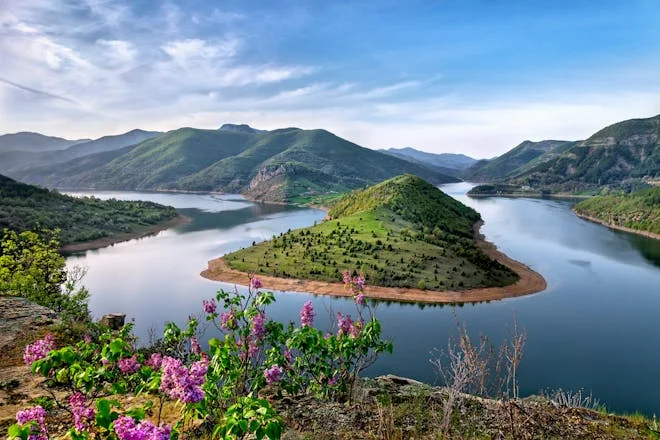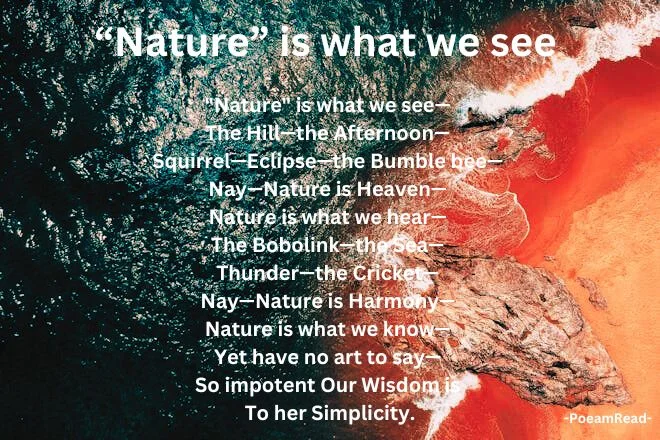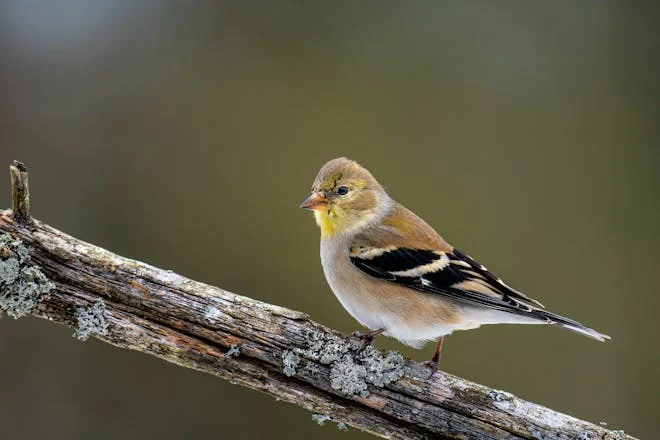
Welcome to a journey into the world of Emily Dickinson’s poetry. Emily Dickinson’s poetry often leaves readers in awe, and “Nature is what we see” is no exception. This poem, like a gem, has multiple facets, each reflecting a unique aspect of nature and human perception.
In this article, we will explore the various literary aspects of this poem, including its subject, the author herself, the context in which it was written, the underlying themes and tone, as well as the unique form and structure that make it a masterpiece of poetic expression.
Nature is what we see— "Nature" is what we see— The Hill—the Afternoon— Squirrel—Eclipse—the Bumble bee— Nay—Nature is Heaven— Nature is what we hear— The Bobolink—the Sea— Thunder—the Cricket— Nay—Nature is Harmony— Nature is what we know— Yet have no art to say— So impotent Our Wisdom is To her Simplicity.
Content
- About the Author: Emily Dickinson
- The Subject of "Nature is what we see"
- The Context of "Nature is what we see"
- Theme and Tone of “Nature is what we see”
- Form and Structure of "Nature is what we see"
- Line-by-line analysis of Emily Dickinson's poem "Nature" is what we see
- Literary and poetic devices of "Nature is what we see" By Emily Dickinson
- Interactive Summary
- Conclusion
About the Author: Emily Dickinson
Before we delve deeper into the poem itself, let’s take a moment to appreciate the brilliance of its creator, Emily Dickinson. Born in Amherst, Massachusetts, in 1830, Dickinson was a reclusive poet who lived most of her life in solitude. Despite her seclusion, she crafted a remarkable body of work that explored powerful themes such as love, death, nature, and the human experience.
Dickinson’s unique style and unconventional use of punctuation and capitalization set her apart from her contemporaries. Her poems often delve into the depths of the human soul, offering profound insights and reflections on life’s mysteries.
The Subject of “Nature is what we see”
Emily Dickinson’s “Nature is what we see” is a contemplative piece that explores the observable and the ineffable aspects of nature. The poem begins with a simple declaration that nature consists of the things we see: the hill, the afternoon, the squirrel, and the bumblebee. However, Dickinson quickly shifts the perspective, suggesting that nature is also a heavenly experience.
As the poem progresses, Dickinson expands the definition of nature. She includes what we hear: the bobolink, the sea, thunder, and the cricket. Finally, she concludes that nature is harmony. This progression from the physical to the abstract reflects Dickinson’s view. She sees nature as both a sensory experience and a spiritual state of being.
The poem’s subject is not just about the physical elements of nature but also about the human attempt to comprehend its vastness and simplicity. Dickinson acknowledges the limitations of human language and wisdom when faced with nature’s simplicity, suggesting that a true understanding of nature is beyond our grasp.
The Context of “Nature is what we see”
“Nature is what we see” was written around 1863, a time when the Romantic movement had a significant influence on literature and art. This movement emphasized the importance of nature, individual emotion, and the subjective experience of the world.
Dickinson’s poetry often reflects romantic ideals, focusing on the beauty of the natural world and the inner emotions of the individual. In this poem, she engages with themes she frequently explores: the wonder of nature and the human struggle to define and articulate its essence.
Dickinson’s personal life also influences the context of the poem. Known for her reclusive nature, Dickinson found solace and inspiration in the natural world around her. Her poetry serves as a means to express her fascination and her philosophical musings on the relationship between humanity and nature.
In summary, “Nature is what we see” encapsulates the essence of nature through human perception. It resonates with the Romantic era’s focus on nature and individual experience while showcasing Dickinson’s distinct perspective and poetic voice. The poem invites readers to consider the limitations of human understanding and to appreciate the simple yet profound beauty of the natural world.
Theme and Tone of “Nature is what we see”

Emily Dickinson’s “Nature is what we see” is a reflective exploration of the natural world’s beauty and the human inability to fully comprehend it. The poem’s theme centers on the contrast between nature’s vastness and human limitations. Dickinson marvels at the observable elements of nature. These include the hill, the afternoon, the squirrel, and the bumblebee. Additionally, she acknowledges that nature encompasses abstract concepts like heaven and harmony.
The tone of the poem is one of humble admiration mixed with a sense of defeat. Dickinson uses a gentle, contemplative voice to express both the joy of experiencing nature and the frustration of trying to define it. The poem’s speaker admits that while we can see and hear nature and know it in some way, our wisdom falls short of capturing its true essence.
Dickinson’s choice of words and the structure of the poem reinforce this theme and tone. The use of dashes and the lack of consistent rhyme create a rhythm that feels both natural and unpredictable, much like nature itself. The poem’s tone suggests that nature is a higher power, one that we can appreciate and enjoy but never fully master or explain.
In essence, “Nature is what we see” invites readers to embrace the mystery of the natural world. The poem encourages us to appreciate the simple yet powerful experiences that nature offers. It also suggests accepting that some aspects of nature will always remain beyond our understanding.
Form and Structure of “Nature is what we see”
Emily Dickinson’s “Nature is what we see” is a twelve-line poem that is contained within a single stanza, known as block form. This structure is quite fitting for the poem’s subject, as it mirrors the continuous and boundless aspects of nature itself.
The poem does not follow a traditional rhyme scheme, but Dickinson employs end rhymes sporadically throughout, creating a pattern that can be represented as ABABCADAFAHA. This irregularity in rhyme reflects the poem’s theme of nature’s ineffable beauty and complexity, which defies neat categorization.
In terms of rhythm, the poem is predominantly written in trimeter, which means most lines have three metrical feet. This creates a swift, almost fleeting cadence that echoes the transient experiences of observing nature.
Dickinson’s characteristic use of dashes introduces pauses that break the flow, inviting readers to contemplate the images and ideas presented. The minimal punctuation allows for multiple interpretations and emphasizes the elusive quality of nature’s essence.
The poem’s lack of a consistent rhyme scheme and its variable meter underscore the central message. It emphasizes that nature is a force that far exceeds humanity’s ability to fully understand or express it. Dickinson’s form and structure in this poem are a testament to her innovative style. They also showcase her ability to capture the ineffable in words.
Line-by-line analysis of Emily Dickinson’s poem “Nature” is what we see
“Nature” is what we see—”
This opening line sets the thematic foundation for the poem. Dickinson asserts that nature is defined by what we observe, suggesting that our perception shapes our understanding of the natural world. Furthermore, the use of quotation marks around “Nature” suggests that Dickinson is defining the term in her own, perhaps unconventional, way.
The Hill—the Afternoon—
Here, Dickinson offers specific examples of what constitutes nature, mentioning a hill and the time of day, afternoon. These concrete images ground the abstract concept of nature in tangible elements of the physical world. Additionally, the capitalization of “Hill” and “Afternoon” personifies these elements, elevating their status in the natural world.
Squirrel—Eclipse—the Bumble bee—”
Continuing with concrete examples, Dickinson lists various natural phenomena, including a squirrel, an eclipse, and a bumblebee. The poet continues with more specific imagery, mentioning animals and celestial events that capture attention and inspire awe.
The dash after “Squirrel” and before “Eclipse” may indicate a sudden shift in focus from the mundane to the extraordinary. Each image contributes to the richness of nature, highlighting its diversity and complexity.
Nay—Nature is Heaven—”
This line introduces a twist in the poem’s exploration of nature. Dickinson suggests that nature transcends earthly elements, equating it with heaven. This expansion of the concept adds depth to the poem’s thematic exploration.
Nature is what we hear—”
Shifting from visual to auditory perception, Dickinson emphasizes the role of sound in experiencing nature. This line broadens the scope of the poem, inviting readers to consider the sensory richness of the natural world. Therefore, this line begins to explore nature as an experience that encompasses all senses.
The Bobolink—the Sea—”
Similar to the previous stanza, Dickinson provides specific examples of natural sounds, mentioning the call of a bird (Bobolink) and the roar of the sea. These auditory images evoke a sense of the vastness and diversity of nature’s soundscape.
Thunder—the Cricket—”
Continuing the theme of natural sounds, Dickinson includes thunder and the chirping of a cricket. These contrasting sounds further highlight the breadth of nature’s auditory palette, from the sublime to the mundane.
Nay—Nature is Harmony—”
Here, Dickinson asserts that nature is characterized by harmony. Despite the diversity of sounds mentioned earlier, they coalesce into a harmonious whole, reflecting the interconnectedness of all elements in nature.
Nature is what we know—”
Shifting focus once again, Dickinson explores the concept of knowledge in relation to nature. This line suggests that our understanding of nature is limited by our capacity to perceive and comprehend it.
Yet have no art to say—”
Here, Dickinson acknowledges the limitations of language in capturing the essence of nature. Despite our knowledge and experience, words fail to fully convey the depth and complexity of the natural world.
So impotent Our Wisdom is
This line underscores the inadequacy of human wisdom when confronted with the vastness and mystery of nature. Despite our attempts to understand and explain it, nature remains elusive and ineffable.
To her Simplicity.”
In the final line of the poem, Dickinson returns to the theme of simplicity, suggesting that nature’s beauty lies in its inherent simplicity. Despite our attempts to analyze and categorize it, nature defies our understanding, reminding us of the humility inherent in our relationship with the natural world.

Emily Dickinson’s “Nature is what we see” provides a deep reflection on the natural world and our role in it through its concise and powerful verses. By exploring the sensory richness of nature and the limitations of human perception, Dickinson invites readers to contemplate the beauty, mystery, and harmony of the world around us.
Literary and poetic devices of “Nature is what we see” By Emily Dickinson
Imagery
Dickinson utilizes vivid imagery throughout the poem to evoke sensory experiences and bring the natural world to life. For example, she paints pictures of hills, squirrels, eclipses, bumblebees, and the sea, appealing to the reader’s senses of sight and sound.
Symbolism
The natural elements mentioned in the poem serve as symbols that represent broader ideas and themes. For instance, the hill may symbolize stability or endurance, while the sea might symbolize vastness or eternity. These symbols add depth and layers of meaning to the poem.
Personification
Dickinson personifies nature by attributing human qualities to it, such as in the lines “Nature is Heaven” and “Nature is Harmony.” By personifying nature, Dickinson emphasizes its significance and suggests a spiritual or divine aspect to it.
Alliteration
The repetition of consonant sounds in close proximity creates a musical quality and emphasizes certain words or phrases. For example, in the line “The Bobolink—the Sea—,” the repetition of the “b” sound draws attention to the natural sounds being described.
Repetition
Dickinson employs repetition throughout the poem to reinforce key themes and ideas. For instance, the repetition of the phrase “Nay—Nature” in lines 4 and 8 emphasizes the speaker’s assertions about the nature of nature itself.
Assonance
Similar to alliteration, assonance involves the repetition of vowel sounds within words or phrases. Dickinson uses assonance to create internal rhyme and enhance the musicality of her verses. For example, in the line “The Hill—the Afternoon—,” the repetition of the long “e” sound in “Hill” and “Afternoon” creates a harmonious effect.
Enjambment
Dickinson frequently employs enjambment, the continuation of a sentence or phrase across line breaks, in her poetry. This technique creates a sense of fluidity and momentum, allowing ideas to flow seamlessly from one line to the next. An example of enjambment in “Nature” is what we see— occurs between lines 2 and 3, where the thought continues uninterrupted from “The Hill—the Afternoon—” to “Squirrel—Eclipse—the Bumble bee—.”
Slant Rhyme
Dickinson is known for her use of slant rhyme, where the end sounds are similar but not exact matches, as seen in “see,” “bee,” “Sea,” and “Simplicity.” This creates a subtle harmony that echoes the poem’s theme.
Paradox
Dickinson employs paradoxical statements throughout the poem to highlight the complexities and contradictions inherent in our perception of nature. For example, the assertion that “Nature is what we see—” is followed by the declaration that “Nature is Heaven—,” suggesting both the tangible and transcendent aspects of nature simultaneously.
Onomatopoeia
Words like “Thunder” and “Cricket” mimic the sounds they represent, drawing the reader’s auditory attention to the sounds of nature.
Punctuations
Emily Dickinson’s distinctive use of punctuation, particularly her liberal use of dashes, is one of the defining features of her poetic style. Scholars have long debated the purpose and impact of her unconventional punctuation choices. The dashes may indicate pauses, interruptions, or shifts in thought, and they contribute to the rhythmic and introspective nature of her poetry.
Dickinson’s sparse use of traditional punctuation marks like commas and periods adds to the ambiguity and open-endedness of her verses. This invites readers to engage more actively with the text. Her approach to punctuation was revolutionary for her time and continues to influence modern poetry. It challenges readers to explore the layers of meaning in her work.
Interactive Summary
As we reflect on Emily Dickinson’s “Nature is what we see,” we’re reminded of the poem’s exploration of the natural world through a blend of vivid imagery and profound thought. Dickinson’s verse invites us to experience nature’s sights and sounds, leading us to a deeper understanding of its harmonious essence.
Her unique punctuation and structure prompt introspection, while her literary devices enrich our interpretation. Consider how nature’s simplicity speaks to you and which aspects resonate with your own experiences.
Conclusion
Emily Dickinson’s “Nature is what we see” is a poetic meditation on sensory and intellectual encounters with the natural world. It’s a celebration of nature’s grandeur and an acknowledgment of the limits of human expression. Through her masterful use of language and form, Dickinson encourages us to appreciate the ineffable qualities of nature.
As we conclude our analysis, we carry with us a renewed appreciation for the subtleties of nature and the power of poetry to articulate the indescribable. Let this poem be an invitation to look at the world around us with wonder and curiosity, finding joy in the harmony that nature offers.
If you enjoyed “Nature is what we see”, I highly recommend reading our analysis of “A Man Said to the Universe” by Stephen Crane for its exploration of existence and our place in the universe.
RELATED POSTS
View all



